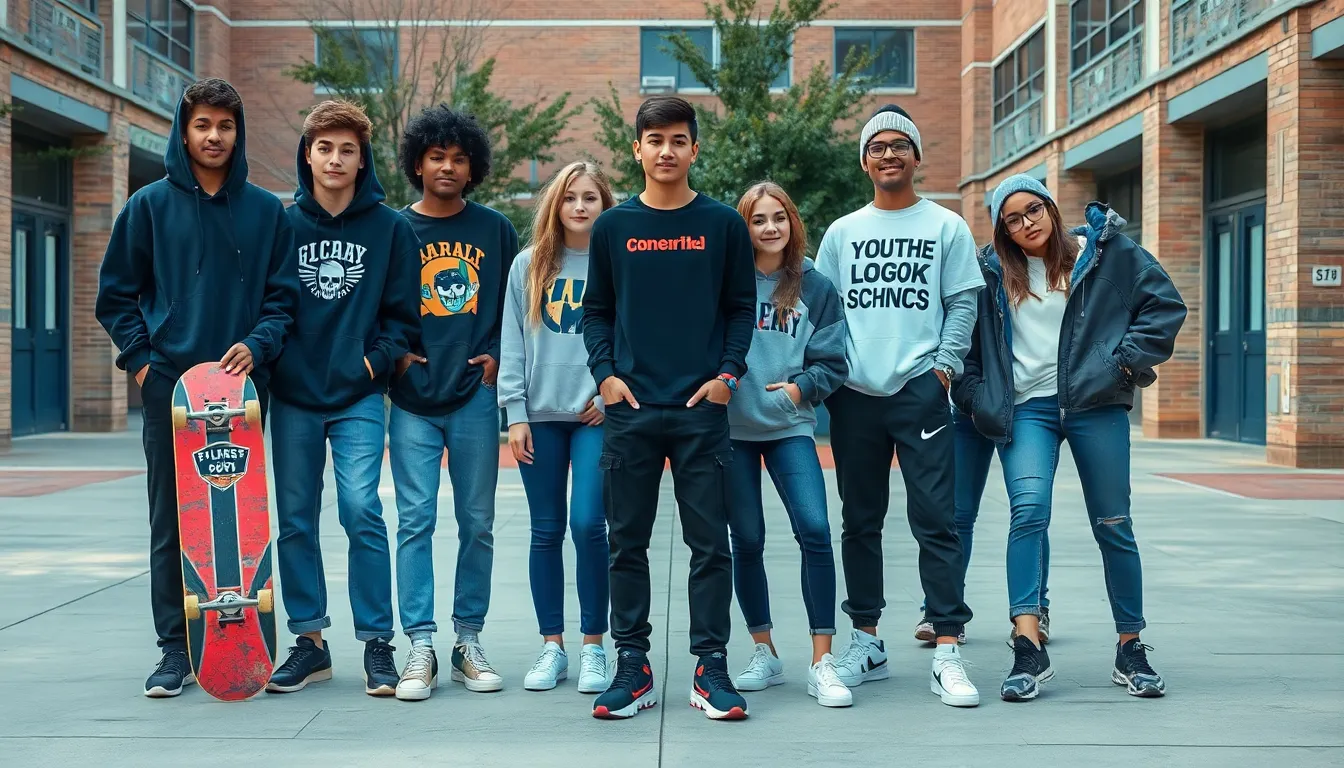Table of Contents
ToggleHigh school fashion is more than just clothing; it’s a powerful form of self-expression that shapes identity during those formative years. As students navigate the complexities of adolescence, their style choices reflect personal tastes, social circles, and even cultural influences. From the latest sneaker trends to vintage thrift finds, high schoolers are constantly redefining what it means to be fashionable.
In today’s digital age, platforms like Instagram and TikTok play a significant role in shaping trends, allowing students to showcase their unique styles and draw inspiration from peers around the world. The evolving landscape of high school fashion not only highlights individual creativity but also fosters a sense of community among students. Understanding these trends can provide valuable insights into the vibrant world of youth culture.
Overview of High School Fashion
High school fashion serves as a vital arena for self-expression and identity exploration among adolescents. Students often showcase their individuality through a blend of personal style and trends from social circles. These choices reflect their interests, values, and social affiliations.
Influences from social media platforms like Instagram and TikTok heavily impact students’ fashion decisions. Trends emerge rapidly, allowing students to follow, adapt, and create styles that resonate with their peers. Users engage with content, promoting both personal brands and communal identities.
Additionally, cultural factors play a significant role in shaping high school fashion. Local customs, socioeconomic backgrounds, and demographic characteristics often dictate the availability and acceptance of specific styles. The result is a diverse array of fashion trends that varies widely across different schools.
In high school environments, various factors such as climate, school dress codes, and extracurricular activities further influence fashion choices. Casual wear dominates in many settings, but formal events and social gatherings encourage more polished attire. Overall, high school fashion embodies a dynamic mix of influences, reflecting not only individual preferences but also broader cultural movements within youth culture.
Current Trends in High School Fashion

High school fashion continually evolves, reflecting both individual style and broader cultural influences. Current trends highlight the merging of comfort and individuality, particularly through streetwear and athleisure styles.
Streetwear Influence
Streetwear dominates high school fashion with its blend of casual and urban aesthetics. Brands like Supreme, Off-White, and Palace set the tone with bold graphics and oversized fits. Hoodies, graphic tees, and distressed jeans feature prominently in daily outfits. Layering accessories, such as caps and chunky sneakers, enhance personal expression. Students often mix high-end pieces with thrifted items, showcasing creativity and sustainability.
Athleisure Styles
Athleisure combines athletic and casual wear, offering comfort without sacrificing style. Brands like Nike and Adidas lead with trendy leggings, stylish joggers, and breathable tops. These items serve dual purposes, fitting both gym routines and school settings. Popular choices include matching sets and oversized sweatshirts, appealing for their versatility. Athleisure allows students to transition seamlessly from classes to after-school activities.
Iconic High School Fashion Eras
High school fashion has evolved dramatically through the decades, influenced by cultural shifts and youth movements. Each era reflects unique styles that have shaped adolescent identity.
The 80s and 90s
The 1980s and 1990s marked a vibrant evolution in high school fashion, characterized by bold colors and distinct styles.
- Bold Patterns: Students embraced neon colors, geometric patterns, and oversized clothing, allowing for individual expression.
- Athletic Wear: Tracksuits and sneakers from brands like Adidas and Reebok became staples, promoting a casual, sporty aesthetic.
- Grunge Movement: The early 90s saw the rise of grunge, with flannel shirts, ripped jeans, and combat boots popularized by bands like Nirvana.
- Street Style: Hip-hop culture introduced baggy jeans and graphic tees, influencing students to mix and layer outfits for a personalized look.
The 2000s Revival
The 2000s experienced a revival of earlier styles, blending influences from various decades into a new trend.
- Y2K Aesthetic: Low-rise jeans, cargo pants, and crop tops, reflecting the early 2000s vibe, became common among high schoolers.
- Pop Culture Influence: Celebrities like Britney Spears and Paris Hilton shaped styles, with logos and designer brands gaining popularity.
- Emo and Scene Styles: Influenced by music genres, students adopted skinny jeans, band tees, and colorful hairstyles, expressing emo and scene identities.
- Athleisure Emergence: Comfortable yet fashionable clothing such as yoga pants and graphic hoodies marked a shift towards practicality while maintaining style.
Each of these eras has left a lasting impression on high school fashion, contributing to the rich tapestry of adolescent self-expression today.
High School Fashion for Different Personalities
High school fashion reflects the diverse personalities of students, allowing them to express individuality through various styles. Each fashion choice resonates with specific traits, attitudes, and social affiliations.
Preppy Styles
Preppy styles evoke an air of sophistication and classic elegance. Key components include tailored blazers, polo shirts, and loafers. Brands like J. Crew and Lacoste dominate this look. Students often pair chinos or khakis with pastel colors, embodying a polished yet approachable vibe. Accessories such as headbands and cable-knit sweaters enhance the overall preppy aesthetic. This style is popular among those leaning toward traditional values and organized social activities, providing a timeless look that maintains relevance in high school wardrobes.
Alternative Fashion Choices
Alternative fashion choices encompass a wide spectrum of styles that challenge mainstream trends. Key elements include vintage clothing, DIY modifications, and bold statement pieces. Many students embrace punk, goth, or bohemian influences, often representing their unique perspectives. Clothing may feature graphic tees, ripped jeans, and combat boots, showcasing individuality and creativity. Accessories like chokers, handmade jewelry, and eclectic hats contribute to these distinctive looks. This style resonates with students who prioritize authenticity and self-expression, fostering a sense of community among like-minded peers.
How to Build a High School Wardrobe
Building a high school wardrobe involves selecting versatile, stylish pieces that reflect personal taste and cater to various occasions. Here are key steps to consider:
- Assess Personal Style
Identify preferences by considering favorite colors, patterns, and clothing types. Explore various styles like preppy, streetwear, or bohemian to discover what resonates.
- Invest in Basics
Acquire essential items such as plain t-shirts, jeans, and comfortable sneakers. These staples form a foundation, making it easier to mix and match outfits.
- Incorporate Trendy Pieces
Add a few on-trend items that can elevate everyday outfits. Popular choices include oversized hoodies, statement jackets, and graphic tees. Staying updated with current fashion trends from social media is beneficial.
- Choose Versatile Outerwear
Select jackets that work for multiple occasions, such as denim jackets, bombers, or light parkas. Outerwear enhances outfits while providing warmth and style.
- Prioritize Comfort
Fashion should not compromise comfort. Opt for breathable fabrics, like cotton and blends, especially for school days filled with activities.
- Accessorize Thoughtfully
Use accessories like hats, belts, and jewelry to personalize looks. Accessories amplify individuality without overwhelming outfits.
- Adapt for Events
Prepare for different occasions by including formal attire for events, such as blazers, dress shirts, or nice shoes. This ensures readiness for presentations or school dances.
- Organize the Wardrobe
Maintain organization by grouping items by type. A well-organized closet simplifies outfit selection and enhances daily dressing efficiency.
- Explore Thrift Shops
Thrift shopping provides unique opportunities to find vintage and one-of-a-kind pieces while promoting sustainability. This aligns fashion with budget-consciousness.
- Rotate Seasonally
Adapt clothing collections by rotating seasonal items, ensuring the wardrobe stays relevant throughout the academic year. This strategy keeps style fresh and functional.
These strategies support the creation of a high school wardrobe that balances personal expression and practicality, aligning with the evolving trends and diverse styles observed in high school environments.
High school fashion serves as a vibrant canvas for self-expression and individuality. As students navigate their formative years they utilize clothing to communicate their identities and connect with peers. The influence of social media and cultural trends ensures that fashion remains dynamic and ever-evolving.
From streetwear to athleisure the trends reflect a blend of comfort and personal style. Each choice made in the hallway or classroom contributes to a larger conversation about identity and belonging. By embracing their unique fashion sense students not only showcase their creativity but also foster a sense of community among their peers.
Ultimately high school fashion is more than just clothing; it’s a powerful tool for self-discovery and expression in a world that’s constantly changing.





